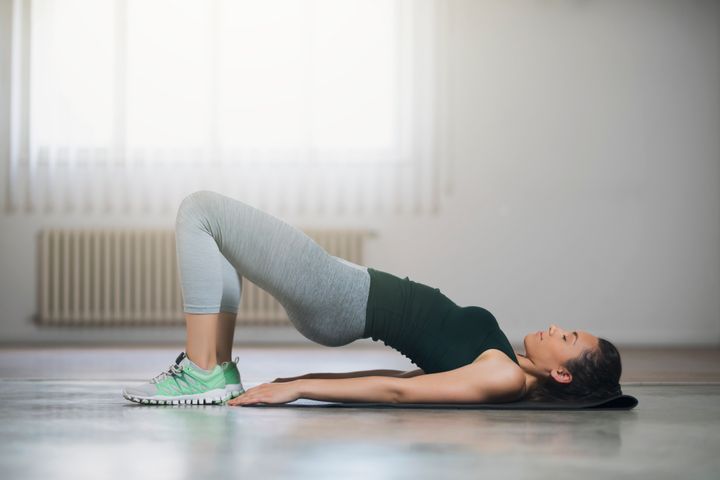Wisdom comes with age. But flexibility? It feels like we lose a little limberness every year — and that can come with some (*ahem*) stiff consequences.
It’s not just that you can’t do the splits or touch your toes like you used to. Having tighter muscles can affect your ability to navigate day-to-day life, something you may have already started to feel if you have a job that requires a lot of sitting.
Luckily, there’s one easy thing you can do to combat this: stretch your hip flexors.
While all types of stretches are good for your body, focusing on your hip flexors is especially important to maintain mobility as you get older. Tight hip flexors can cause lower back pain and muscle fatigue and stretching them can improve balance and resolve other issues, according to a 2021 meta-analysis.
Gavin Hamer, a physical therapist and the national director of clinical education at Fyzical Therapy & Balance Centers, told HuffPost that “stretching will positively affect the joints, ligaments, and muscles around the hip.”
“Flexible muscles are less likely to become strained, and mobile joints are kept healthy by improving circulation and lubrication,” Hamer added.
Not to mention, flexible hips lead to “greater stride length and more effective reactions to balance challenges,” according to Hamer.
Why Do We Lose Flexibility?
Dr. Georgiy Brusovanik, an orthopedic surgeon and spine and bone specialist at Miami Spine Doctor, said that we lose disc height in our spines when we age, leading to a loss of lumbar lordosis, which is the natural inward curve of your spine.
“Think of it as we get more and more pitched forward,” he explained. “An extreme example of this is our elderly who may have a difficult time even looking up at the horizon.” This is a slow process that happens over time.
“Loss of hip cartilage is inevitable just like loss of knee cartilage and loss of disc height,” he said, adding that doing hip extensions (i.e., stretching your hips) will help slow this down.
“As the joint capsule ages, it gets inflamed and ossifies — parts of it literally turn to bone,” he said. “Stretching may counter that process and maintain a more natural range of motion.”
SrdjanPav via Getty Images
The Best Stretch To Help With Your Hip Flexors
To directly balance out the normal hip flexion position (think: curling in a ball at night or sitting rounded forward during the day), Brusovanik suggested doing hip extensions.
To do a hip extension, lie flat on your back with your knees bent in front of you. Place your hands on the floor under your lower back, then lift your hips as high as you can in a “bridge” pose.
Doing this stretch is “paramount to counter loss of disc height that is due to disc degeneration,” according to Brusovanik. He added that it’s “key to both maintaining upright posture as well as having the ability to keep a long, healthy stride during walking and running.”
In addition to the “bridge,” Hamer suggested incorporating stretching routines or exercises, like yoga or Pilates, into daily life, as they can “significantly help maintain joint mobility” by stimulating circulation and lubrication.
“While aging inevitably changes our bodies, taking proactive steps to preserve hip flexibility can significantly improve the quality of life,” he explained. “By embracing regular exercise routines that prioritize joint mobility and health, individuals can potentially mitigate the effects of aging on hip stiffness and maintain an active lifestyle for years to come.”
Hamer recommended six additional stretches to try if you want to work on your hip flexibility even more:
- Forward crouch: Stand in front of a sturdy chair with your feet hip-width apart. Hold the back of the chair and squat down, bending your knees and keeping your back straight. Breathe out as you go down until you feel your butt and thighs working, then breathe in as you come back up, repeating 10 times.
- Wide crouch: Stand with your feet wider than hip-width apart and your knees and feet turned out. Hold the back of a sturdy chair and squat, making sure to keep your butt out and your back straight. Do the same breathing as before, repeating 10 times.
- Side lunge: In a wide stance, place the chair to your side. Bend your knees, shifting your pelvis away from the chair and leaning your shoulders toward the chair. You should feel the stretch on the inside leg closest to the chair. Breathe out and add a little more stretch, continuing for 30 seconds and repeating twice on each leg.
- Forward lunge: With the chair still at your side, position your feet in a lunge position with your front foot farther away from the chair. Bend your forward knee 30 degrees and angle your back foot toward the chair. Raise the arm not holding onto the chair up toward the ceiling, then draw the hip on your forward leg back. Hold for 30 seconds, repeating twice on each leg.
- Seated figure-four: Sit at the edge of a sturdy chair, putting one leg straight out in front of you and crossing the opposite ankle over the straight leg’s shin. Use your hands to pull the ankle up toward your hip as much as you can. Then, with your hands behind your back, lean forward at the hips, breathing in and out and leaning forward a little bit more. Hold for 30 seconds and repeat twice on each side.
- Butterfly: Sit on the floor with the soles of your feet facing each other and touching. Your knees should be out wide to your sides and your back should be tall. Lean forward at the hips, placing your hands on your back for support, and stretch as much as you can with each breath in and out. Hold for 30 seconds and repeat twice.
Always consult with your doctor before starting any new exercise routine. And if you are experiencing pain when rotating your hips (or if you have to hold your pants to help lift your leg in and out of the car), then you should make a consultation with an orthopedic surgeon. You’ll need to make sure a larger problem, like injury or hip arthritis, isn’t to blame.
For everyone else, taking a few minutes a day to stretch out your hips can make a huge difference in your ability to walk and tackle each day. Everyone will lose flexibility eventually, but taking steps to slow down the process can have a lasting impact on your quality of life.


